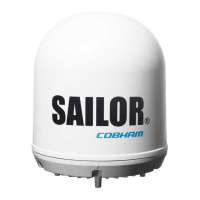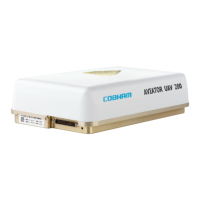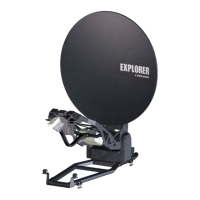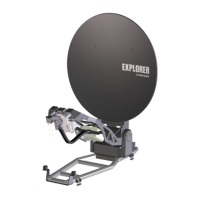Chapter 1: Introduction Page: 15 Welcome Congratulates the user on their purchase and introduces the system.
Main Units Describes the main components of the SAILOR 500/250 FleetBroadband systems.
Coverage Shows the Inmarsat I4 satellite coverage map and notes on service availability.
Service Limitations Outlines limitations related to SIM lock, available services, and coverage areas.
Chapter 4: Using the Web Interface Page: 79 Using the Dashboard Describes the Dashboard's use for inspecting communication and viewing system status.
Properties Details the information displayed in the Dashboard's PROPERTIES section.
Short Dial Explains how to use short dial numbers from the phone book for easier calling.
Port Forwarding Explains how to set up port forwarding for servers connected to the terminal in router mode.
Call Barring Details how to bar incoming and/or outgoing calls using the Banning PIN.
Call Waiting Explains how to set up notification for waiting calls during active calls or data transmission.
Line Identification Describes how to configure the terminal to display the user's number during calls or data transmission.
Closed User Group Explains how to define settings for closed user groups, allowing calls only within the group.
Setting Up Tracking Explains how to set up the terminal for tracking purposes by reporting position to a server.
Selecting the Language Explains how to change the web interface language from English to other supported languages.
Administration Provides access to administrative settings for system management.
Call Charges Allows users to enter tariffs to automatically calculate call and data session charges.
Log Handling Explains how to clear call logs and reset time counters.
Data Limits Allows setting data usage limits for standard data connections and streaming sessions.
Using Profiles Defines profiles as collections of QoS settings and explains how to select or define them.
Defining New Profiles Guides on defining new profiles by editing user-defined profiles or selecting subscribed settings.
Remote Management Guides on configuring the terminal for remote control via web interface or AT commands.
Multi-voice Guides on enabling and configuring the Multi-voice feature for simultaneous calls.
Voice Distress Guides on setting up the terminal for Voice Distress functionality.
Self Test Explains how to activate a system self-test, similar to POST.
Extended Status Describes how to view extended status information for the system and connection.
Site Map Explains how to use the site map page to get an overview of the web interface submenus.
Chapter 5: Troubleshooting Page: 201 Getting Support Guides users on obtaining support from airtime providers or distributors.
System Support Advises contacting distributors for assistance with terminal or antenna problems.
Part Numbers Lists part numbers for system units, including antennas and terminals.
Status Signalling Explains troubleshooting using status signalling methods like indicators, event messages, and logs.
Light Indicators Describes the functions of various LEDs on the terminal for status indication.
Event Messages Explains how the terminal detects and signals events requiring user action.
List of Events Explains common events, their causes, and remedies, particularly those causing warning icons.
Reset Button Explains how to access and use the reset button on the terminal.
Glossary Page: 251 APN Defines Access Point Name and its role in establishing network connections.
BGAN Defines Broadband Global Area Network and its capabilities.
CE Defines Conformité Européenne and its significance for product certification.
CID Defines Context Identifier.
CM Defines Continuous Monitoring.
CS Defines Circuit-Switched networks.
DHCP Defines Dynamic Host Configuration Protocol.
DNS Defines Domain Name System.
ECEF Defines Earth-Centred Earth-Fixed coordinate system.
GPS Defines Global Positioning System.
IAI-2 Defines Inmarsat Air Interface-2 for BGAN.
ICMP Defines Internet Control Message Protocol.
IMEI Defines International Mobile Equipment Identity.
IMSO Defines International Maritime Satellite Organisation.
IP Defines Internet Protocol.
ISDN Defines Integrated Services Digital Network.
kbps Defines kilobits per second.
LAN Defines Local Area Network.
LED Defines Light Emitting Diode.
MAC Defines Media Access Control.
MRCC Defines Maritime Rescue Coordination Centre.
MSN Defines Multiple Subscriber Numbering for ISDN equipment.
NAT Defines Network Address Translation.
PDP Defines Packet Data Protocol.
PIN Defines Personal Identification Number.
PoE Defines Power over Ethernet.
POST Defines Power On Self Test.
PPPoE Defines Point-to-Point Protocol over Ethernet.
PS Defines Packet-Switched.
PUK Defines PIN Unblocking Key.
QoS Defines Quality of Service.
RDI Defines Restricted Digital Information.
RF Defines Radio Frequency.
SAS Defines Satellite Access Station.
SDU Defines Service Data Unit.
SIM Defines Subscriber Identity Module.
SIP Defines Session Initiation Protocol.
SMS Defines Short Messaging Service.
Streaming Defines data transfer as a continuous stream.
TCP Defines Transmission Control Protocol.
UDI Defines Unrestricted Digital Information.
UTC Defines Coordinated Universal Time.
VoIP Defines Voice over IP.
VPN Defines Virtual Private Network.






